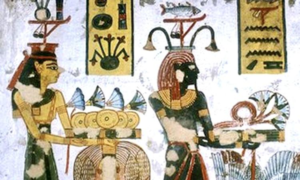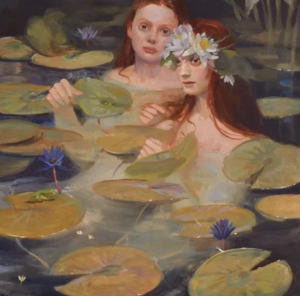The yawkyawk are guardians of fresh waters. They have the upper part of a young woman and the lower part of a fish. They are worshiped by the Aboriginal people of the Western Arnhem Land, Northern Territory, Australia where water lilies thrive.
Discovering the importance of cross-cultural ecology
Darwin was puzzled by the appearance of such a complex structure as flowers on earth some 200 million years ago. Water lilies that grow in water are even more intriguing. Some fossiles are 60 million years old.
Water lilies can be found all around the world, specially in tropical and subtropical climates such as the Arnhem Land, realm of the Yawkyawk. But water lilies are not just beautiful flowers (a beauty that artists from all origins have tried to capture).

They play an important part in the ecosystem of ponds, lakes, rivers by oxygenating the water and providing shade with their leaves for the fish.
The Yugul Mangi Rangers: Cherry Daniels was born and raised on the banks of Arnhem Land’s Roper River. As a child, she would swim among the water lilies in billabongs (pond or pool of water that is left behind when a river alters its course or after floodwaters recede)… She states humorously that billabongs are «like supermarkets, chock a block full of plants and animals that can be eaten». The fruit and the roots of the water lily are edible and can be used for medicinal purposes. However pollution and tree-felling are threatening the billabong ecosystems. So in 2002, Cherry established a group of rangers to restore the land.
When science and tradition collaborate: A couple years later she met Dr Ens. They understood the importance of associating Aboriginal and non-Aboriginals to the project thus promoting the concept of cross- cultural ecology. They combined scientific and indigenous methods to preserve the billabongs. Cherry Daniels told Dr Ens about the songs, stories and ceremonies surrounding them. They both became aware that they were not only preserving the ecosystem ( a crucial task) but saving a cultural and spiritual heritage.
We shall see that water lilies have symbolic meanings in different civilizations before focusing on the intricate relation between these plants and water deities which will bring us back to the yawkyawk.
The water-lily or lotus : a sacred flower in many ancient religions
Water lilies close at sunset and sink under the water to rise and open again at dawn. The flower was a symbol of the Sun, of birth, of the creation of the world in ancient Egypt. When the world was covered in the waters of the primordial Ocean, the Sun emerged, cradled in a huge water lily. The blue lotus is the flower of Osiris. The god and his priests as well as kings are often pictured with crowns of water lilies. The blue lotus was famous for its calming, sedative effects (we now know it contains nuciferin and aporphine).

It was also a sacred flower for the Mayas, a symbol of fertility and harmony. The plant grows in water, sinks its roots in the earth and the underworld and its flower opens to the sun. It unites the primordial elements, earth, water and sky.
In Buddhism, the lotus flower symbolizes enlightenment and spiritual progress. Buddha, deities, kings are often represented sitting on an open lotus flower. It is a recurrent motif in all forms of art (architecture, sculpture, painting, textiles).

Yawkyawk dja waluk ( the young water spirit and the water lilies)
This is the title of a screenprint dating from 2007 by Deborah Wurrkidj. The artist shows two symmetrical water spirits swimming among stylized water lilies. According to the myth the yawkyawk were two sisters who disobeyed sacred rules and were changed into mermaids. In her work, the yawkyawk ( who are most entirely fish) blend in with the water and plants. There is a unity and harmony between the women and the plants. They were said to have long green hair like the vegetation that grows in rivers. Here they are crowned with water lilies ( Anais Zhang has given some of the Heroji avatars hair made of water lilies). We shall also find in other cultures a special bond between water spirits and water lilies but artist D Wurrkidj has truly captured the Aboriginal version of the myth. Pictures are protected by copyright but you can click on the following link to see them: https://babbarra.com/
Water spirits (mermaids, fairies, deities) appear in many myths and legends around the world. They are ambivalent creatures. Sometimes they avoid all human contact ; like fish, they are slippery and slip away when men try to catch them (and the story doesn’t end well when they succeed) and sometimes they are alluring and seductive. The water lily shares the same ambivalence. It can be the symbol of sensuous love with its beautiful petals and intoxicating perfume or a symbol of chastity, purity and even indifference and coldness (like the cold water it grows in).
Pliny the Elder in his Natural History (a sort of Roman pre-Wikipedia) devotes several chapters to medicinal plants. He explains that nympheas (or water lilies) were named after a nymph who fell in love with Hercules. Nymphs were minor female deities devoted to natural elements (trees, mountains and fresh waters). Hercules rejected the love of this nymph. She died of sorrow and was changed into a water lily. Pliny goes on to explain that water lilies are powerful anti- aphrodisiacs. Medieval doctors throughout Europe believed him and infusions of the plant were served to monks in monasteries to help them remain true to their vow of chastity. In European literature, the white water lily became the symbol of unrequited love. We can quote a passage from «Promenade sentimentale» written by French poet Verlaine :

On the other hand, for the Dogons of West Africa, the water lily is a symbol of the female body, specially the thorax and breasts and therefore a symbol of fertility.

Women who had given birth ate the leaves because it was believed that they helped produce milk. We shall quote a few lines from the poem Congo written in French by former President of Senegal, Léopold Sedar Senghor :

The landscape is eroticized with mountains as male elements. The river Congo is personified and becomes a huge female body, the fertile mother of all living things and a passionate lover. Her thighs are furious but her long arms are like «calm water lilies». The river is both an ardent and soothing woman.
Water lilies are sacred flowers in many ancient cultures and the association of the plant with water deities is not specific to the Aboriginal myths but the yawkyawk could live no where else than in the Australian billabongs.
However next time you contemplate water lilies on a pond, be quiet, close your eyes and maybe you will hear the yawkyawk singing the Dreamtime.
Source: https://www.abc.net.au/ (Article about the collaboration between Cherry Daniels and Dr Ens)
Image Source: nma.gov.au, radiofrance.fr, lemonde.fr, templedairy.in, galerie-albane.com
